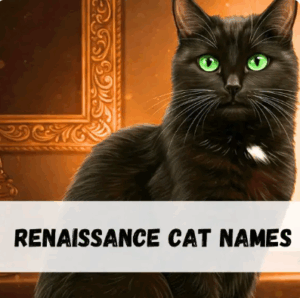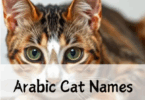The gentle purr of a feline companion has graced human homes for millennia, yet the names we bestow upon these enigmatic creatures evolve with the tides of history. While contemporary pet names often lean towards the whimsical or the human-like, there’s a burgeoning fascination with names that echo the grandeur and intellectual fervor of bygone eras. Among these, Renaissance-inspired cat names are emerging as a captivating trend, offering a unique blend of historical elegance, artistic reverence, and a touch of scholarly charm. This article delves into the rich tapestry of the Renaissance cat names, exploring how its vibrant culture, iconic figures, and profound artistic and intellectual achievements can inspire truly distinctive and meaningful names for our beloved feline friends.

Renaissance Cat Names
Renaissance Inspired Cat Names: An Introduction
Imagine a sleek, ebony cat named “Vespucci,” or a playful ginger tabby answering to “Botticelli.” These aren’t just names; they are whispers of history, imbued with the spirit of an era that redefined art, science, and human potential. Renaissance-inspired cat names offer a delightful departure from the commonplace, providing a sophisticated and intriguing identity for your feline companion. This niche within pet naming taps into a desire for individuality and a connection to a period renowned for its beauty, innovation, and profound intellectual awakening. It’s about more than just a sound; it’s about invoking a mood, a historical context, and a sense of timeless elegance.
The Renaissance Era: A Brief Background
To truly appreciate the wellspring of Renaissance-inspired names, one must first understand the era itself. The Renaissance, meaning “rebirth” in French, was a period in European history, generally spanning from the 14th to the 17th century, marking the transition from the Middle Ages to modernity. It was characterized by a renewed interest in classical Greek and Roman culture, a flourishing of art, literature, science, and philosophy, and a shift from a predominantly theological worldview to one that embraced humanism and individualism.
Originating in Florence, Italy, the Renaissance saw the rise of powerful city-states, wealthy merchant families like the Medicis who became ardent patrons of the arts, and groundbreaking discoveries in various fields. Iconic figures like Leonardo da Vinci, Michelangelo, Raphael, and Shakespeare emerged, leaving an indelible mark on human civilization. This period was a crucible of creativity, where beauty, intellect, and exploration converged, forever changing the course of Western thought and artistic expression. It was a time of immense human achievement, exploration, and a profound rediscovery of human potential, making it a fertile ground for inspiring unique and meaningful names.
Why Renaissance-Inspired Cat Names?
The allure of Renaissance-inspired cat names extends beyond mere aesthetics. There are several compelling reasons why pet owners are increasingly drawn to this sophisticated category:
- Elegance and Sophistication: Names like “Isabella” or “Cosimo” possess an inherent grace and timeless charm that elevates them beyond typical pet names. They evoke a sense of refinement and a connection to a rich cultural heritage.
- Uniqueness and Individuality: In a world saturated with common pet names, a Renaissance-inspired name stands out. It’s a conversation starter, reflecting a thoughtful and distinctive choice by the owner.
- Connection to History and Art: For those who appreciate art history, classical literature, or the intellectual achievements of the Renaissance, these names offer a direct link to a passion. Naming your cat “Raphael” or “Beatrice” is a subtle nod to your interests and an homage to historical greatness.
- Meaningful Associations: Many Renaissance names carry historical weight or specific meanings. “Leonardo” signifies strength and bravery, while “Sophia” means wisdom. Choosing a name with a relevant meaning can add another layer of connection to your pet’s personality.
- Evoking a Sense of Mystery and Intrigue: The very sound of some Renaissance names can conjure images of ancient libraries, grand cathedrals, or sun-drenched Italian landscapes, adding a touch of mystique to your feline friend.
- Timeless Appeal: Unlike trendy names that might fade in popularity, Renaissance names have endured for centuries, ensuring that your cat’s name will remain elegant and relevant throughout its life.
Categories of Renaissance-Inspired Cat Names
To navigate the vast possibilities of Renaissance names, it’s helpful to categorize them based on their origin and inspiration. This approach allows for a more targeted search, ensuring you find the perfect fit for your cat’s personality and appearance.
Top Renaissance-Inspired Cat Names
Here’s a curated list of some of the most popular and evocative Renaissance-inspired cat names, encompassing a broad range of origins and appeals. These names have a timeless quality and are easily pronounceable, making them excellent choices for any feline companion.
Names Inspired by Renaissance Artists
The Renaissance was an epoch of unparalleled artistic brilliance, giving birth to masterpieces that continue to inspire awe. Naming your cat after a celebrated artist of this era is a beautiful way to pay homage to creativity and genius. These names often carry a sense of gravitas and artistic flair.
- Leonardo: (Leonardo da Vinci) The quintessential Renaissance man, a painter, sculptor, architect, musician, scientist, inventor, anatomist, geologist, cartographer, botanist, and writer. A fitting name for a curious and intelligent cat.
- Michelangelo: (Michelangelo di Lodovico Buonarroti Simoni) Renowned sculptor, painter, architect, and poet. Ideal for a majestic or strong-willed feline.
- Raphael: (Raffaello Sanzio da Urbino) A master painter and architect of the High Renaissance. A good choice for a graceful and elegant cat.
- Botticelli: (Sandro Botticelli) Famous for his mythological paintings like “The Birth of Venus.” A whimsical and artistic name for a beautiful cat.
- Donatello: (Donato di Niccolò di Betto Bardi) A pioneering sculptor of the Early Renaissance. Suitable for a cat with a strong presence.
- Titian: (Tiziano Vecellio) Leading painter of the Venetian school. For a cat with rich, warm fur.
- Caravaggio: (Michelangelo Merisi da Caravaggio) A revolutionary Baroque painter known for his dramatic chiaroscuro. A bold name for a cat with a dramatic personality.
- Tintoretto: (Jacopo Comin) A prominent Venetian painter of the late Renaissance.
- Veronese: (Paolo Caliari) Another influential Venetian painter.
- Giotto: (Giotto di Bondone) Considered one of the fathers of Italian Renaissance painting. A classic and strong name.
Names Inspired by Renaissance Literature
The Renaissance was a golden age for literature, producing timeless works that continue to resonate today. These names evoke intellectual depth, poetic beauty, and often a touch of romanticism or drama.
- Dante: (Dante Alighieri) Author of “The Divine Comedy.” A powerful and evocative name for a cat with a commanding presence.
- Beatrice: (Beatrice Portinari) The muse of Dante Alighieri’s “Divine Comedy.” A beautiful and romantic name for a female cat.
- Petrarch: (Francesco Petrarca) Often called the “Father of Humanism,” a renowned poet. A sophisticated name for a thoughtful cat.
- Laura: (Laura de Noves) The beloved muse of Petrarch’s poetry. A classic and elegant name.
- Boccaccio: (Giovanni Boccaccio) Author of “The Decameron.” A quirky and intellectual name.
- Chaucer: (Geoffrey Chaucer) Author of “The Canterbury Tales,” a seminal figure in English literature. A charming and traditional name.
- Shakespeare: (William Shakespeare) Though slightly later, his works were profoundly influenced by Renaissance humanism. A grand name for a dramatic cat.
- Ophelia: (From Shakespeare’s Hamlet) A beautiful and tragic name.
- Romeo: (From Shakespeare’s Romeo and Juliet) A classic romantic name.
- Juliet: (From Shakespeare’s Romeo and Juliet) A timeless and romantic name.
Names Inspired by Renaissance Architecture
The architectural innovations of the Renaissance transformed cityscapes, creating structures that were both monumental and harmonious. Names inspired by Renaissance architecture carry a sense of strength, balance, and enduring beauty.
- Brunelleschi: (Filippo Brunelleschi) Architect of the Florence Cathedral dome. A strong and distinctive name.
- Andrea: (Andrea Palladio) Influential architect known for his villas. A classic and elegant name.
- Bramante: (Donato Bramante) Key High Renaissance architect. A stately name.
- Verona: A beautiful city in Italy, renowned for its Roman and Renaissance architecture. A lovely name for a female cat.
- Florence: The birthplace of the Renaissance, a city synonymous with art and architecture. A popular and charming unisex name.
- Siena: A stunning medieval city in Tuscany, famous for its unique architecture. A graceful name.
- Venice: A city known for its canals and unique architectural style, a major center during the Renaissance. A romantic and fluid name.
- Pisa: Home of the Leaning Tower. A distinctive and memorable name.
- Arno: The river that flows through Florence, a central element of the city’s Renaissance landscape. A natural and flowing name.
- Urbino: A small, picturesque city in central Italy, an important center of the Renaissance. A unique and charming name.
Male Renaissance Inspired Cat Names
When choosing a male Renaissance name, consider those that exude strength, intellect, or a historical presence. These names often have a robust sound and a rich backstory.
- Alessandro: Meaning “defender of mankind,” a classic Italian name.
- Cesare: A powerful Roman and Renaissance name.
- Fabio: Meaning “bean grower,” a common and charming Italian name.
- Giovanni: Meaning “God is gracious,” a very popular Italian name.
- Guido: Meaning “wood,” a classic Italian name.
- Leonardo: (As above)
- Lorenzo: (Lorenzo de’ Medici) A powerful Florentine ruler and patron of the arts. A regal and sophisticated name.
- Marco: (Marco Polo) Though pre-Renaissance, his spirit of exploration aligns with the era’s inquisitiveness.
- Niccolo: (Niccolò Machiavelli) Influential political philosopher. A unique and intellectual name.
- Salvatore: Meaning “savior,” a strong and classic Italian name.
- Silas: Meaning “forest, wood,” a timeless and slightly rustic name.
- Valerius: A Roman family name, meaning “to be strong.”
- Vespasian: Roman emperor, a strong and historical name.
- Vittorio: Meaning “victory,” a triumphant name.
- Maximilian: A powerful name of German origin, associated with a Holy Roman Emperor.
Female Renaissance Inspired Cat Names
Female Renaissance names often possess an ethereal beauty, a classic elegance, or a connection to powerful historical women. They can be graceful, strong, or deeply romantic.
- Allegra: Meaning “joyful, lively,” a beautiful and positive name.
- Aurora: The Roman goddess of dawn, symbolizing new beginnings.
- Bianca: Meaning “white,” perfect for a pale or white cat.
- Camilla: A classic name with Roman roots, associated with strength.
- Caterina: (Caterina Sforza) A formidable Renaissance noblewoman. A strong and regal name.
- Eleonora: A royal and elegant name, common among European nobility.
- Emilia: A classic Italian name, meaning “rival.”
- Giulia: The Italian form of Julia, meaning “youthful.”
- Isabella: (Isabella d’Este) A powerful patron of the arts and culture. A regal and popular choice.
- Lavinia: An ancient Roman name, elegant and timeless.
- Lucrezia: (Lucrezia Borgia) A controversial but prominent figure of the Renaissance. A bold name.
- Mona: (As in Mona Lisa) A mysterious and iconic name.
- Seraphina: Meaning “fiery ones,” a beautiful and evocative name.
- Sophia: Meaning “wisdom,” a classic and elegant choice.
- Viola: Meaning “violet,” a delicate and pretty name.
Unisex Renaissance Inspired Cat Names
For those seeking a name that defies traditional gender roles, or perhaps for a cat whose gender is unknown, unisex Renaissance names offer versatile and equally compelling options. Many of these are inspired by places or concepts rather than specific individuals.
- Arno: (As above)
- Capri: A beautiful Italian island, evocative of warmth and beauty.
- Florence: (As above)
- Genoa: A major port city during the Renaissance. A strong and distinctive name.
- Luna: Meaning “moon,” a celestial and timeless name.
- Medici: (House of Medici) The powerful Florentine banking family, synonymous with Renaissance patronage. A unique and grand name.
- Pisa: (As above)
- Rome: The Eternal City, central to classical and Renaissance history. A strong and iconic name.
- Siena: (As above)
- Stella: Meaning “star,” a bright and charming name.
- Tuscan: Referring to the region of Tuscany, the heartland of the Renaissance. A rustic yet elegant name.
- Umbria: A region in central Italy, known for its artistic heritage.
- Veneto: A region in northeastern Italy, home to Venice.
- Verona: (As above)
- Vespucci: (Amerigo Vespucci) An Italian explorer, after whom America is named. A historical and adventurous name.
How to Choose the Perfect Renaissance Name for Your Cat
Selecting a name for your feline friend is a joyous, yet sometimes daunting, task. When narrowing down your Renaissance-inspired choices, consider the following:
- Personality: Does your cat exhibit traits that align with a particular historical figure or artistic style? A playful and mischievous cat might be a “Dante,” while a serene and elegant one could be an “Isabella.”
- Appearance: Does your cat’s fur color, eye color, or overall demeanor suggest a certain name? A ginger cat might suit “Titian” (known for his use of warm colors), while a majestic Maine Coon could be a “Michelangelo.”
- Sound and Flow: Say the name aloud several times. Does it roll off the tongue easily? Is it easy for your cat to recognize? Avoid names that are too long or overly complicated.
- Uniqueness vs. Familiarity: Decide if you want a truly unique name that requires explanation or one that is recognizable but still distinctive.
- Personal Connection: Does the name hold any personal significance for you? Perhaps you’re an art history enthusiast, or you simply love the sound of a particular name.
- Shortenings and Nicknames: Consider if the chosen name can be easily shortened into a cute nickname for everyday use. “Leonardo” could become “Leo,” “Isabella” could be “Bella.”
- Research the Meaning: Before finalizing, take a moment to research the historical figure or meaning behind the name. This can add another layer of depth and appreciation to your choice.
The Influence of Renaissance on Modern Pet Naming Trends
The resurgence of Renaissance-inspired cat names is not an isolated phenomenon. It reflects a broader shift in modern pet naming trends, moving away from purely cutesy or human-like names towards those with more gravitas, historical significance, or unique cultural associations. This trend is driven by several factors:
- Desire for Individuality: Pet owners are increasingly seeking names that reflect their own unique tastes and interests, moving away from generic options.
- Growth of “Sophisticated” Pet Ownership: As pets become more integrated into families and lives, there’s a desire to bestow names that reflect their importance and the owner’s elevated perception of their companion.
- Interest in History and Culture: A growing appreciation for historical periods, art, and literature fuels the desire to incorporate these passions into everyday life, including pet naming.
- Impact of Pop Culture: While not directly Renaissance-related, the popularity of historical dramas and period pieces can subtly influence naming choices, making historical names feel more familiar and appealing.
- Nostalgia and Timelessness: In a fast-paced world, there’s a longing for the enduring beauty and stability of the past. Renaissance names offer a connection to this sense of timelessness.
This trend is likely to continue, as pet owners increasingly view their companions as extensions of their own personalities and interests, seeking names that are not only fitting but also reflective of a rich cultural heritage.
Conclusion
Choosing a Renaissance-inspired name for your cat is more than just a naming decision; it’s an embrace of history, art, and timeless elegance. These names offer a unique blend of sophistication, individuality, and a connection to an era that profoundly shaped Western civilization. By bestowing such a name, you not only give your feline companion a distinctive identity but also infuse your home with a touch of the grandeur and intellectual curiosity that defined the Renaissance. It’s a choice that resonates with beauty, history, and a subtle nod to the enduring human spirit.
Frequently Asked Questions (FAQs)
Q1: Are Renaissance cat names too formal for a casual pet? A1: Not at all! While many Renaissance names carry a formal air, they can be easily softened with nicknames (e.g., Leonardo to Leo, Isabella to Bella). The beauty lies in their versatility, offering both a grand full name and a charming, casual endearment.
Q2: Will my cat understand a Renaissance name? A2: Cats respond to the sound and tone of their name, not its historical context. As long as the name is consistent and used positively, your cat will associate it with themselves. The meaning and historical connection are more for the owner’s enjoyment.
Q3: Are there any Renaissance names that are too long or difficult to pronounce? A3: Some Renaissance names can be quite long (e.g., Brunelleschi). While unique, consider if it’s practical for daily use and if it rolls off the tongue easily. If you love a long name, think about a shorter, recognizable nickname.
Q4: Can I combine a Renaissance name with a modern surname for my cat? A4: Absolutely! Many pet owners enjoy giving their cats a full name, often combining a first name with a playful or human-like “surname.” For example, “Dante Whiskerton” or “Isabella Meowington.”
Q5: Where can I find more Renaissance-inspired names beyond this list? A5: Explore lists of famous Renaissance figures (artists, scientists, rulers), geographical locations from the era (cities, regions), and even characters from Renaissance literature. Art history books and documentaries are also excellent resources.






